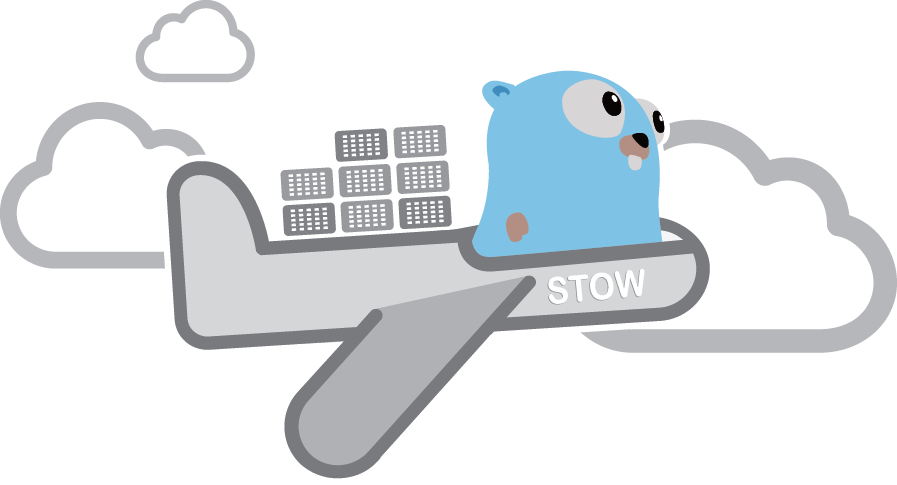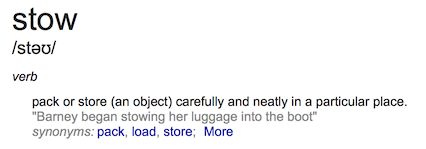Cloud storage abstraction package for Go.
-
Version: 0.1.0
-
Project status: Stable. Approaching v1 release
-
It is recommended that you vendor this package as changes are possible before v1
-
Contributors: Mat Ryer, David Hernandez, Ernesto Jiménez, Corey Prak, Piotr Rojek, Jason Hancock
-
Artwork by Mel Jensen inspired by Renee French and and is licensed under the Creative Commons Attribution 3.0 License
Stow provides implementations for storage services, blob stores, cloud storage etc. Read the blog post announcing the project.
- Local (folders are containers, files are items)
- Amazon S3
- Google Cloud Storage
- Microsoft Azure Blob Storage
- Openstack Swift (with auth v2)
- Oracle Storage Cloud Service
- SFTP
The concepts of Stow are modeled around the most popular object storage services, and are made up of three main objects:
Location- a place where manyContainerobjects are storedContainer- a named group ofItemobjectsItem- an individual file
location1 (e.g. Azure)
├── container1
├───── item1.1
├───── item1.2
├───── item1.3
├── container2
├───── item2.1
├───── item2.2
location2 (e.g. local storage)
├── container1
├───── item1.1
├───── item1.2
├───── item1.3
├── container2
├───── item2.1
├───── item2.2
- A location contains many containers
- A container contains many items
- Containers do not contain other containers
- Items must belong to a container
- Item names may be a path
- Using Stow
- Connecting to locations
- Walking containers
- Walking items
- Downloading a file
- Uploading a file
- Stow URLs
- Cursors
Import Stow plus any of the implementation packages that you wish to provide. For example, to support Google Cloud Storage and Amazon S3 you would write:
import (
"github.com/khalid79/stow"
_ "github.com/khalid79/stow/google"
_ "github.com/khalid79/stow/s3"
)The underscore indicates that you do not intend to use the package in your code. Importing it is enough, as the implementation packages register themselves with Stow during initialization.
- For more information about using Stow, see the Best practices documentation.
- Some implementation packages provide ways to access the underlying connection details for use-cases where more control over a specific service is needed. See the implementation package documentation for details.
To connect to a location, you need to know the kind string (available by accessing the Kind constant in the implementation package) and a stow.Config object that contains any required configuration information (such as account names, API keys, credentials, etc). Configuration is implementation specific, so you should consult each implementation to see what fields are required.
kind := "s3"
config := stow.ConfigMap{
s3.ConfigAccessKeyID: "246810",
s3.ConfigSecretKey: "abc123",
s3.ConfigRegion: "eu-west-1",
}
location, err := stow.Dial(kind, config)
if err != nil {
return err
}
defer location.Close()
// TODO: use locationYou can walk every Container using the stow.WalkContainers function:
func WalkContainers(location Location, prefix string, pageSize int, fn WalkContainersFunc) errorFor example:
err = stow.WalkContainers(location, stow.NoPrefix, 100, func(c stow.Container, err error) error {
if err != nil {
return err
}
switch c.Name() {
case c1.Name(), c2.Name(), c3.Name():
found++
}
return nil
})
if err != nil {
return err
}Once you have a Container, you can walk every Item inside it using the stow.Walk function:
func Walk(container Container, prefix string, pageSize int, fn WalkFunc) errorFor example:
err = stow.Walk(containers[0], stow.NoPrefix, 100, func(item stow.Item, err error) error {
if err != nil {
return err
}
log.Println(item.Name())
return nil
})
if err != nil {
return err
}Once you have found a stow.Item that you are interested in, you can stream its contents by first calling the Open method and reading from the returned io.ReadCloser (remembering to close the reader):
r, err := item.Open()
if err != nil {
return err
}
defer r.Close()
// TODO: stream the contents by reading from rIf you want to write a new item into a Container, you can do so using the container.Put method passing in an io.Reader for the contents along with the size:
contents := "This is a new file stored in the cloud"
r := strings.NewReader(contents)
size := int64(len(contents))
item, err := container.Put(name, r, size, nil)
if err != nil {
return err
}
// item represents the newly created/updated itemAn Item can return a URL via the URL() method. While a valid URL, they are useful only within the context of Stow. Within a Location, you can get items using these URLs via the Location.ItemByURL method.
If you have a Stow URL, you can use it to lookup the kind of location:
kind, err := stow.KindByURL(url)kind will be a string describing the kind of storage. You can then pass kind along with a Config to stow.New to create a new Location where the item for the URL is:
location, err := stow.Dial(kind, config)You can then get the Item for the specified URL from the location:
item, err := location.ItemByURL(url)Cursors are strings that provide a pointer to items in sets allowing for paging over the entire set.
Call such methods first passing in stow.CursorStart as the cursor, which indicates the first item/page. The method will, as one of its return arguments, provide a new cursor which you can pass into subsequent calls to the same method.
When stow.IsCursorEnd(cursor) returns true, you have reached the end of the set.

